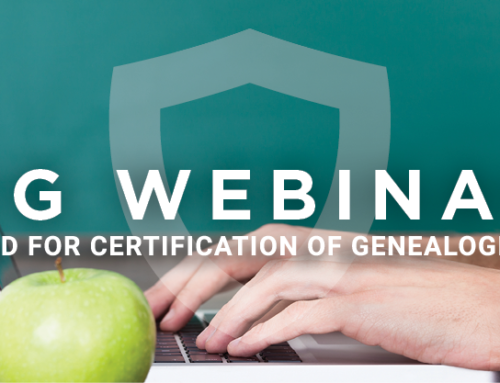By Judy Kellar Fox, CG®
 Let’s look at the searching part of research. As in the last post on research, we’ll see that it’s more involved than just looking.
Let’s look at the searching part of research. As in the last post on research, we’ll see that it’s more involved than just looking.
Genealogy Standards offers this goal of reasonably exhaustive data-collection: “Genealogists attempt to collect all information potentially relevant to the questions they investigate.”[1] Got that? All information. All potentially relevant information. Potentially relevant to the questions under investigation.
Our research question determines what “reasonably exhaustive” research looks like. We start with a problem, most commonly a question of identity or kinship. The individuals, what we want to know about them, the time and place in which they lived, and their life circumstances set the course of our research.
Time and place. Our research subjects lived in specific places in specific time periods. If we don’t know about the place or time period, we have to educate ourselves about history and geography at the least. Relevant considerations include
- historical boundaries and their changes,
- migration patterns and routes,
- what sources are available in the relevant times and places.[2]
Life circumstances also determine the direction of our research. Aside from our subjects’ gender, race, and ethnicity, their life patterns suggest numerous research paths and types of sources. They interacted with legal and governmental entities and religious institutions. They may have served in the military or participated in social clubs. They had financial and trade dealings. They spoke a language and often left traces of their handwriting. They had many or few belongings of different kinds. They were wealthy or poor, free or enslaved. They left a legacy in their descendants’ DNA. Thinking of our subjects as people in families and communities suggests a wide variety of sources to discover and examine. Looking at all these factors in the relevant times and places will potentially lead us to a wide variety of sources that may name or bear on our research subjects.[3]
Quality information. At the outset the list of types of sources to be researched can be quite long. It includes “databases, finding aids, indexes, search engines . . . authored narratives, derivative sources, and documented and undocumented genealogies.”[4] However, we aim, wherever possible, to find the original records alluded to in other works and information provided by informants as close as possible to the events in question.[5] Sometimes this effort draws out our research time and effort considerably, all in the pursuit of “reasonably exhaustive” research.
The idea of testing our hypotheses addresses “reasonably exhaustive” research head-on.[6] Not only do we seek and gather data, but we also compare items to each other. Depending on how they correlate with other information, we accept them as evidence for or against our hypotheses. Some information may conflict, pushing us to research more until we can resolve discrepancies. Reasonably exhaustive research extends beyond searching to the mental effort of evaluating and processing our data to be sure we can test our theories.[7]
If we don’t have enough data to test, we broaden our search. We extend it to include our subject’s family, associates, and neighbors. We then seek out the same types of information indicated above, but for a wider circle of people.[8] This can be very time consuming and result in the accumulation of much data. Within it, however, we may well find the evidence we need to answer our research question.
So how do we know when it’s safe to stop? Watch for the next “10-Minute” post.


